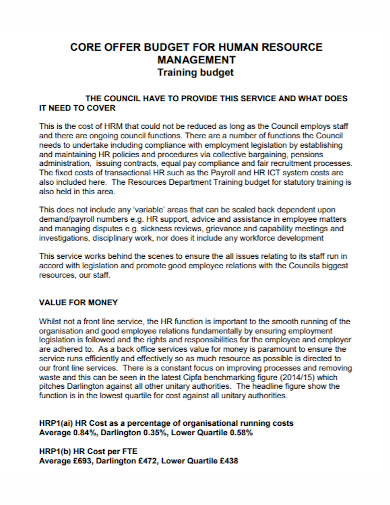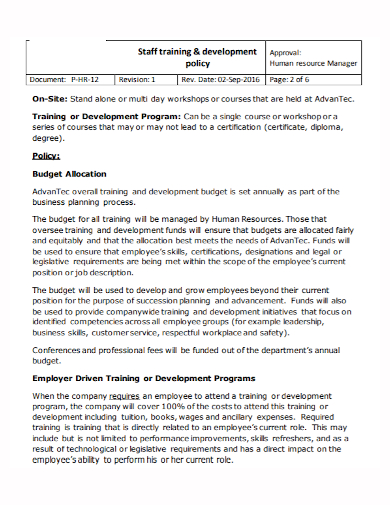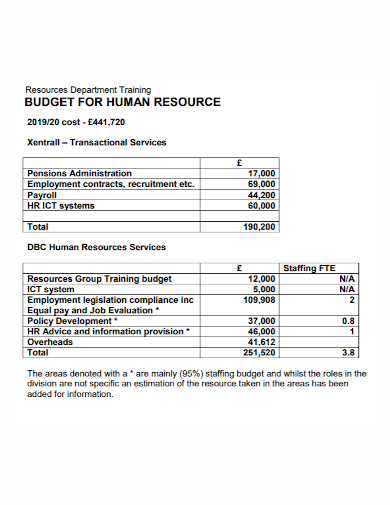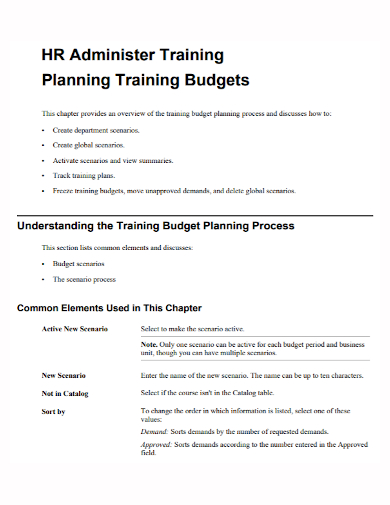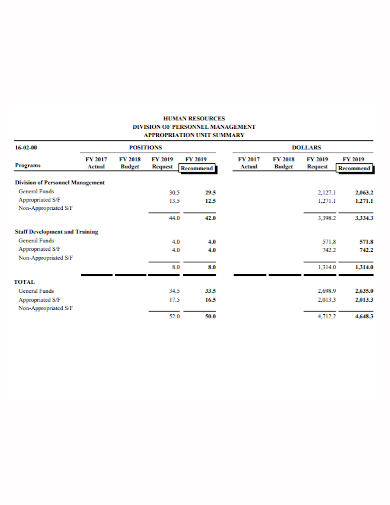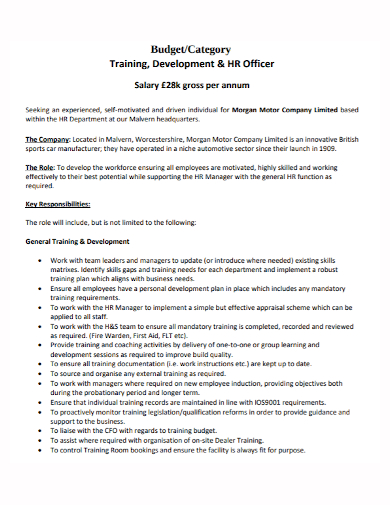When it comes to managing human resources, the HR department has many roles and responsibilities. Aside from recruitment, handling payrolls and benefits, updating company policies, maintaining employee records, and administrating disciplinary actions this department is also in charge of conducting various employee or corporate-related trainings. When we speak of training, this can come in different forms such as new employee training and orientation, career development, or workplace safety training. But as we all know training programs can cost, whether the HR department conducts the training by themselves or hire a professional trainer or mentor. In most cases, the HR department would have to come up with an HR training budget to seek approval from top management in order to proceed with these training programs. Read more about this in our article below, and should you need any help working on that budget we have several free HR training budget samples made available on this page.
10+ HR Training Budget Samples
1. HR Training Budget Template
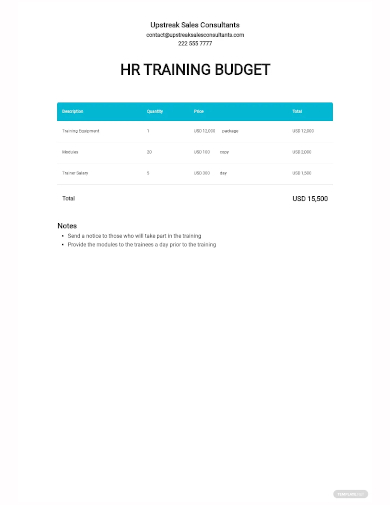
2. HR Management Training Budget
3. HR Employee Training Budget
4. HR Staff Allocation Training Budget
5. HR Training Department Budget
6. HR Administer Training Budget Plan
7. HR Development Training Budget
8. Agency HR Training Budget Policy
9. HR Officer Training Budget
10. Sample HR Training Budget
11. Company HR Training Budget
What Is an HR Training Budget?
Budgeting can be used for personal reasons to help you save money, evenly distribute your funds, or for companies that need to align their business goals with their finances. Budgeting is all about setting your priorities and creating a detailed plan on how you should manage your finances, whether this is for personal reasons, or for business purposes. It is an effective way to limit your spending and making sure you are on the right track, financially. The same thing goes for an HR training budget, as much as they want to help and further develop their employees, at the end of the day it’s all about priorities. About which should go first and will the management be able to afford it. Since companies are not only spending for their employees but they have a lot of things to think about as well. So an HR training budget must be able to convince management how important training programs are and these should effectively increase a company’s income more than they have bargained for. Establishing a training budget for your organization ensures you allocate appropriate funds for employee development over the course of a year. By planning for training expenses and linking them to strategic objectives, you typically avert cost-cutting measures that could reduce your training budget if executives perceive it as overhead.
How To Create an HR Training Budget?
A training budget will depend on what particular training programs will be conducted. Each industry has different views on its training programs, some of which are mandatory in nature. But normally trainings should be able to help accomplish a company’s strategic goals. So aside from the financial aspect, the HR department should be able to come up with a solid training proposal that top management would approve of. So to start, here are several pointers that can help you create an HR training budget.
1. Business Goals
When organizing your training budget, you must first and foremost align the company’s business goals with its finances. And setting up what needs to be prioritized first. For example, it is important to train employees with the latest software or system that can help increase revenue? Or perhaps is a safety workshop needed at this time of the year? If you state your company’s goal is to reduce product errors, eliminate waste and improve customer satisfaction, you might consider training that certifies your personnel in quality management techniques. You should also need to check if it is feasible enough to conduct various training programs. Or which should be done first as not to overuse the funds that are being set aside.
2. Alternatives or Options
Different types of training programs can be either administered by the HR department or you will need to hire a professional trainer. Try to weigh in each option you have, think of the benefits it would bring about, and if the budget permits maybe you may opt to hire a trainer instead. With this, you will need to go over their training proposals and check if the information given is not only beneficial for the company’s growth and development of its employees but if the trainings provided is something the company can invest in.
3. Mangining Training Expenses
Once you are able to identify which specific training programs should be conducted within the given period, you will need to then narrow down the cost and expenses. Break down each cost accordingly by providing estimates associated with courses and materials needed to analyze, design, develop, implement, evaluate, and maintain employee training or retraining.
4. Unexpected Expenses
Unexpected or indirect expenses are bound to pop out every now and then, which is why the HR department must be able to set aside funds to cover these overheads.
5. Monitoring Expenses
It is important that even after you have submitted your budget to top management that you continuously monitor the expenses associated with training activities and ensure you’re getting the most for your money. Make sure that every training program provided is attended and that you can also coordinate with other departments in the company to see if there is an improvement in an employee’s performance. By monitoring can help you assess and make necessary changes that can help the department save further in cost and reduce spending.
FAQs
Why Are Trainings Important in a Business Organization?
Employee training or other relevant work-related training is important to ensure that the employees are able to adapt to their working environment, be able to manage the changes and keep up with the latest trends. And more importantly, this is to help further enhance an employee’s skills and expertise in their field so they can be of benefit to the company they are working for.
Why Is Budgeting Important To a Company?
Aside from being able to save money, budgeting can help estimate a company’s anticipated revenue and expenses for an upcoming time period. Detailing past performance and providing a tool for forecasting the fiscal year, or another time period, with a view of assets, revenue, and expenses.
What Is a Budget Proposal?
A budget proposal is used to provide a financial budget plan for the company when it comes to projects and campaigns. This document will serve as a basis for the finance department to assess how much is needed to implement these.
HR administered trainings can be beneficial to their respective companies if planned and budgeted correctly. Start working on that HR training budget now so you may be able to implement the training programs your company needs.
Related Posts
FREE 20+ Sample Training Reports
FREE 19+ Training Proposal Samples
FREE 15+ Sample HR Report
FREE 12+ Sample Training Request Forms
FREE 11+ Sample HR Resource
FREE 10+ Sample Training Agreement
FREE 10+ HR Assessment Checklist Samples
FREE 9+ Human Resources Management Plan Samples
FREE 41+ Sample Budget Forms
FREE 15+ Human Resources Director Job Description Samples
FREE 13+ Training Agreement Contract Samples
FREE 11+ Training Needs Assessment Samples
FREE 10+ Strategic Training Plan Samples
FREE 3+ Management Training Proposal Samples
FREE 3+ Employee Training Proposal Samples

